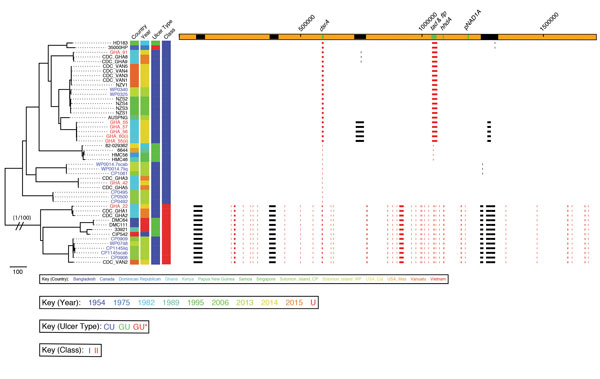Direct Whole-Genome Sequencing of Cutaneous Strains of Haemophilus ducreyi
Michael Marks
1
, Maria Fookes
1, Josef Wagner, Rosanna Ghinai, Oliver Sokana, Yaw-Adu Sarkodie, Anthony W. Solomon, David C.W. Mabey, and Nicholas R. Thomson
Author affiliations: London School of Hygiene & Tropical Medicine, London, UK (M. Marks, R. Ghinai, A.W. Solomon, D.C.W. Mabey, N.R. Thomson); Hospital for Tropical Diseases, London (M. Marks, A.W. Solomon, D.C.W. Mabey); Wellcome Trust Sanger Centre, Cambridge, UK (M. Fookes, J. Wagner, N.R. Thomson); Solomon Islands Ministry of Health and Medical Services, Honiara, Solomon Islands (O. Sokana); Kwame Nkrumah University of Science and Technology, Kumasi, Ghana (Y.-A. Sarkodie)
Main Article
Figure 2

Figure 2. Phylogenetic tree of Haemophilus ducreyi genome sequences inferred from mapping using the H. ducreyi 35000HP strain as reference and after removing high-density single-nucleotide polymorphisms regions with Gubbins (3). Included are published genomes (black text), Ghanaian strains (gray text, GHA designations), and Solomon Islands strains (gray text, CP/WP designations). Sequences from cutaneous ulcers in Ghana and the Solomon Islands were found within both previously described clades of H. ducreyi class I and class II. Scale bar indicates nucleotide substitutions per site. An expanded version of this figure providing complete phylogeny details, including countries of origin, years, ulcer types, and genome region designations, is provided in Technical Appendix 1 Figure.
Main Article
Page created: March 19, 2018
Page updated: March 19, 2018
Page reviewed: March 19, 2018
The conclusions, findings, and opinions expressed by authors contributing to this journal do not necessarily reflect the official position of the U.S. Department of Health and Human Services, the Public Health Service, the Centers for Disease Control and Prevention, or the authors' affiliated institutions. Use of trade names is for identification only and does not imply endorsement by any of the groups named above.
